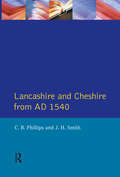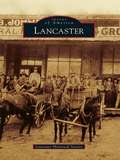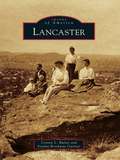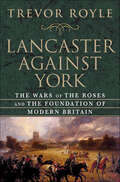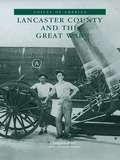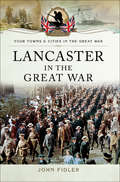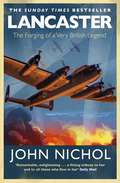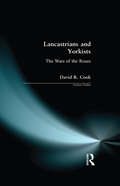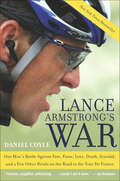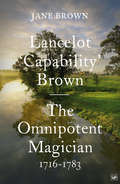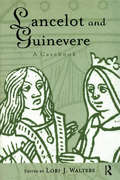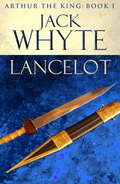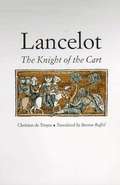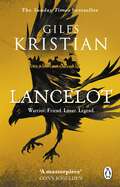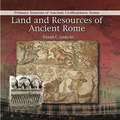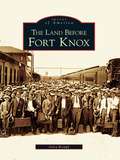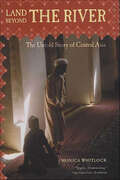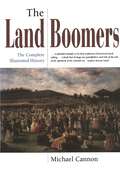- Table View
- List View
Lancashire and Cheshire from AD1540 (Regional History of England)
by C. B. Phillips J. H. SmithThis series, fully illustrated with maps and half-tones, is written for general readers as well as the student. In illuminating the anonymous lives of our predecessors it will, when complete, substantially enrich our understanding of the many histories which together make up the history of England. This authoritative volume surveys the modern history of the counties of Lancashire, Merseyside, Greater Manchester and Cheshire. In 1540 this was a backward area, poor, underpopulated and conservative. During the seventeenth and early eighteenth century the spread of the first cottage industries to the mills and the mines transformed the region into one of the engines of Britain's nineteenth-century greatness. The causes, the costs and the consequences of that transformation are vividly portrayed in this very readable text. Offers a succinct account and analysis of the first region to experience the developed factory system. Discusses the rise, dominance and decline of the region which has parallels across the country and the world. Provides essential background text for the students of local history. Assumes no previous knowledge of the region.
Lancashire's Historic Pubs
by Peter ThomasIf you enjoy the occasional pub meal, a drink at the bar, or if you're interested in Lancashire's social history, you're sure to find something entertaining in Peter Thomas's introduction to the county's pubs. It opens with a round-up of the history of brewing, pubs and ale-selling, and a section on Lancashire's pub signs, though most of the book is dedicated to an A-Z of over fifty of the most interesting inns. Their history, architecture, ghosts and associated legends are all featured, as well as the exploits of their famous and infamous landlords and landladies. Peter's exhaustive research has resulted in a gem of a book which brings together the proud history, traditions and customs associated with Lancashire hostelries; from ale tasting at the Plough at Eaves to the Britannia Coconut Dancers at the Crown Inn at Bacup. A fascinating journey, with plenty of refreshment stops along the way, this will appeal to anyone with an interest in local history, and those who'd like to know more about the convival surroundings in which they might enjoy a pint.
Lancashire's Seaside Piers: Also Featuring the Piers of the River Mersey, Cumbria and the Isle of Man
by Martin EasdownIn this, a companion volume to his definitive history of Yorkshires pleasure piers, Martin Easdown turns his expert attention westward to the Lancashire coast. His highly illustrated survey of the piers constructed at famous resorts like Blackpool, Morecambe, Southport and St Annes-on-Sea celebrates structures that are among the most exuberant and evocative of the Victorian age. Each of these historic piers has its own character and story, yet all of them represent the optimistic style of the British seaside resort at the peak of its popularity. In those days the Lancashire coast, and Blackpool in particular, became the principal holiday destination for the workers of the nearby industrial towns during their Wakes Weeks. The piers that survive are fascinating relics of that lost age.In this meticulously researched account, Martin Easdown describes how these extraordinary buildings came to be constructed, how they were designed and financed, how they were used, and how hazards beset them fire, storm, ship collision, war damage and ever-present threat of insolvency. His entertaining book reveals and records a neglected aspect of the history of Lancashire and the northwest.
Lancaster
by Lancaster Historical SocietyIn 1841, the Republic of Texas was on the brink of bankruptcy, and it needed to attract new immigrants in order to survive. With this important goal in mind, in 1844 the Texas congress authorized the republic's president, Sam Houston, to contract with individuals to colonize the state. In September of that same year, one group headed by Capt. Roderick Rawlins from Illinois came to Texas and settled in what would become the town of Lancaster. Farmers grew grains and cotton, and Lancaster became a trade center with a lively town square. A commercial club organized in order to coordinate advertising for local businesses, and it also held trade days that later became town fairs. Local residents worked hard all week and enjoyed horse races, baseball, "forty-two" parties, music performances, and other entertainment on the weekends. By the late 1800s, Lancaster was connected to the rest of the state by the railroads, but the town still retained its independent, small-town Texas character.
Lancaster (Images of America)
by Connie L. Rutter Sondra Brockway GartnerLancaster, Ohio, with a population of around 35,000, sits snuggled among the rolling hills at the base of a sandstone bluff that the Wyandot Indians called "Standing Stone." Just east of the Hock-Hocking River in Fairfield County and a few miles southeast of Columbus, Lancaster was founded on November 10, 1800, by Col. Ebenezer Zane (1747-1811). The city's rich history is celebrated today in one of the most significant historic districts in the Midwest, known as Square 13. The city offers a walking tour of the area, originally designed in 1800. In a 24-block area, 89 buildings have been designated on the National Register of Historic Places, and the Sherman House Museum is listed as a National Historical Landmark.
Lancaster Against York: The Wars of the Roses and the Foundation of Modern Britain
by Trevor RoyleIn this sweeping history, Trevor Royle details one of the bloodiest episodes in British history. The prize was the crown of England, and the players were the rival houses of Lancaster and York. The dynastic quarrel threatened the collapse of the monarchy as a succession of weak rulers failed to deal with an overzealous aristocracy, plunging England into a series of violent encounters. The bloody battles and political intrigue between the rival heirs of King Edward III brought forth one of the most dynamic ruling families of England--the Tudors.
Lancaster County and the Great War (Voices of America)
by John Chandler GriffinThough the machines and technology have changed drastically over the past century, the themes of sacrifice, loyalty, and heroism have been felt by countless generations of American soldiers. While today's armed forces depend on the accuracy of satellites and "smartbombs," the American soldier of the early twentieth century fought under much different circumstances--an era dominated by machine guns, massive artillery, gas masks, biplanes, and trench warfare. Our nation's families, at that time, were full of patriotic pride and were more than willing to give their sons in the fight for democracy. Lancaster County, a rural community in the Palmetto State's Upcountry, was proud to count many of its men as the first volunteers in our country's call to arms. In Lancaster County and the Great War, you will listen to the compelling stories of many of the county's veterans of World War I, from their trials of admission and boot camp to the nightmarish scenes in the barbed-wire-lined, bullet-ridden trenches to the victory celebrations they experienced in foreign landscapes and back at home. Complemented with period photographs, local county newspaper headlines, and wartime posters, these personal histories truly share a unique experience in South Carolina's and our country's past. As you read through these pages, you will feel as if you have been handed a government-issue rifle, journeyed across the East Coast to various training camps, felt the incredible fear and anxiety of battle, and paraded down Lancaster's streets to the ovation of joyous crowds.
Lancaster in the Great War
by John FidlerAlthough Lancaster was the ancient County town, it had a population of only 40,000 in 1914. Of these, it is thought that some 5,000 men saw war service between 1914-18, and over 1,000 did not return. In consequence, the recruiting drives, the tribunals to consider exemption from 1916, and the ever-growing casualty lists provide the main theme for this book.Some 3,000 men had volunteered by December 1914, to join those already serving. While the depot of the Kings Own Royal Lancaster Regiment was in the town, about eighty regiments had Lancaster men in their ranks, and both the casualty lists and the awards for gallantry reflect this.The town was out of range for shelling from the sea, or aerial bombardment, but did experience an explosion at its munitions factory in 1917. Apart from this, the mayor and council endeavoured to continue with their primary duties as far as possible in running the town.
Lancaster: The Forging of a Very British Legend
by John Nichol'The epic story of an iconic aircraft and the breathtaking courage of those who flew her' Andy McNab, bestselling author of Bravo Two Zero 'Compelling, thrilling and rooted in quite extraordinary human drama' James Holland, author of Normandy 44 From John Nichol, the Sunday Times bestselling author of Spitfire, comes a passionate and profoundly moving tribute to the Lancaster bomber, its heroic crews and the men and women who kept her airborne during the country's greatest hour of need. 'The Avro Lancaster is an aviation icon; revered, romanticised, loved. Without her, and the bravery of those who flew her, the freedom we enjoy today would not exist.'Sir Arthur Harris, the controversial chief of Royal Air Force Bomber Command, described the Lancaster as his 'shining sword' and the 'greatest single factor in winning the war'. RAF bomber squadrons carried out offensive operations from the first day of the Second World War until the very last, more than five and a half years later. They flew nearly 300,000 sorties and dropped around a million tons of explosives, as well as life-saving supplies. Over 10,000 of their aircraft never returned. Of the 7,377 Lancasters built during the conflict, more than half were lost to enemy action or training accidents.The human cost was staggering. Of the 125,000 men who served in Bomber Command, over 55,000 were killed and another 8,400 were wounded. Some 10,000 survived being shot down, only to become prisoners of war. In simple, brutal terms, Harris's aircrew had only a 40 per cent chance of surviving the war unscathed.Former RAF Tornado Navigator, Gulf War veteran and bestselling author John Nichol now tells the inspiring and moving story of this legendary aircraft that took the fight deep into the heart of Nazi Germany.
Lancaster: The Second World War's Greatest Bomber
by Leo McKinstryThe Spitfire and the Lancaster were the two RAF weapons of victory in the Second World War, but the glamour of the fighter has tended to overshadow the performance of the heavy bomber. Yet without the Lancaster, Britain would never have been able to take the fight to the German homeland. Highlights the scale of the bomber’s achievements, including the famous Dambusters attacks. With its vast bomb bay, ease of handling and surprising speed, the mighty Lancaster transformed the effectiveness of the Bomber Command. Whilst addressing the political controversy surrounding the bombing offensive against Germany, Leo McKinstry also weaves individual tales into this compelling narrative. Rich characters are brought to life, such as Roy Chadwick the designer, who taught himself engineering at night school and Sir Arthur Harris, the austere head of the Bomber Command. This is a rich saga, a story of triumph over disaster and the history of an iconic plane.
Lancaster: The Second World War's Greatest Bomber
by Leo McKinstryThe Spitfire and the Lancaster were the two RAF weapons of victory in the Second World War, but the glamour of the fighter has tended to overshadow the performance of the heavy bomber. Yet without the Lancaster, Britain would never have been able to take the fight to the German homeland. Highlights the scale of the bomber’s achievements, including the famous Dambusters attacks. With its vast bomb bay, ease of handling and surprising speed, the mighty Lancaster transformed the effectiveness of the Bomber Command. Whilst addressing the political controversy surrounding the bombing offensive against Germany, Leo McKinstry also weaves individual tales into this compelling narrative. Rich characters are brought to life, such as Roy Chadwick the designer, who taught himself engineering at night school and Sir Arthur Harris, the austere head of the Bomber Command. This is a rich saga, a story of triumph over disaster and the history of an iconic plane.
Lancaster: The Second World War's Greatest Bomber
by Leo McKinstryA comprehensive history of Britain's greatest bomber plane.The Spitfire and the Lancaster were the two RAF weapons of victory in the Second World War, but the glamour of the fighter has tended to overshadow the performance of the heavy bomber. Yet without the Lancaster, Britain would never have been able to take the fight to the German homeland. Highlights the scale of the bomber's achievements, including the famous Dambusters attacks. With its vast bomb bay, ease of handling and surprising speed, the mighty Lancaster transformed the effectiveness of the Bomber Command. Whilst addressing the political controversy surrounding the bombing offensive against Germany, Leo McKinstry also weaves individual tales into this compelling narrative. Rich characters are brought to life, such as Roy Chadwick the designer, who taught himself engineering at night school and Sir Arthur Harris, the austere head of the Bomber Command. This is a rich saga, a story of triumph over disaster and the history of an iconic plane.(P)2018 Hodder & Stoughton Limited
Lancastrians and Yorkists: The Wars of the Roses (Seminar Studies)
by D. R. CookThis concise, lucid study charts the complex sequence of events we know today as the War of the Roses. In the thematic chapters of the third section the author assesses the motives and relationships of the principal actors; the real character and impact of the Wars of the Roses; and the nature of Yorkist government.
Lance Armstrong's War: One Man's Battle Against Fate, Fame, Love, Death, Scandal, and a Few Other Rivals on the Road to the Tour de France
by Daniel CoyleNew York Times Bestseller: An “intimate, insightful, unflinching” portrait of the cyclist as he trains for—and triumphs in—the Tour de France (Jon Krakauer, New York Times–bestselling author of Into the Wild).This is an extraordinary story of greatness pushed to its limits; a vivid, behind-the-scenes portrait of perhaps the most accomplished athlete of our time as he vies for a historic sixth straight victory in the toughest sporting event on the planet. It is the true story of a superlative sports figure fighting on all fronts—made newly vulnerable by age, fate, fame, doping allegations, a painful divorce, and an unprecedented army of challengers—while mastering the exceedingly difficult trick of being Lance Armstrong, a combination of world-class athlete, celebrity, regular guy, and, for many Americans, secular saint.With a new afterword by the author, this updated edition features in-depth reporting on Armstrong’s unprecedented seventh consecutive Tour de France victory; new blood doping allegations; his continuing personal and legal battles; and his retirement. A fascinating journey through the little-known landscape of professional bike racing, Lance Armstrong’s War provides a hugely insightful look into the often inspiring, always surprising core of a remarkable athlete and the world that shapes him.“Well-researched and entertaining . . . his reporting is, quite simply, amazing.” —The New York Times“Fueled by superb reporting and the built-in suspense of the 2004 Tour, Lance Armstrong’s War is the equal of its distinguished and very complicated subject.” —Booklist (starred review)“Brisk and brilliant . . . captures the fabulous life and fast times of an international icon—and pierces the mystic heart of motivation itself.” —Hampton Sides, New York Times–bestselling author of Ghost Soldiers
Lancelot 'Capability' Brown, 1716-1783: The Omnipotent Magician
by Jane BrownLancelot Brown changed the face of eighteenth-century England, designing country estates and mansions, moving hills and making flowing lakes and serpentine rivers, a magical world of green. This English landscape style spread across Europe and the world. At home, it proved so pleasing that Brown's influence spread into the lowland landscape at large, and into landscape painting. He stands behind our vision, and fantasy, of rural England. In this vivid, lively biography, based on detailed research, Jane Brown paints an unforgettable picture of the man, his work, his happy domestic life, and his crowded world. She follows the life of the jovial yet elusive Mr Brown, from his childhood and apprenticeship in rural Northumberland, through his formative years at Stowe, the most famous garden of the day. His innovative ideas, and his affable and generous nature, led to a meteoric rise to a Royal Appointment in 1764 and his clients and friends ranged from statesmen like the elder Pitt to artists and actors like David Garrick. Riding constantly across England, Brown never ceased working until he collapsed and died in February 1783 after visiting one of his oldest clients. He was a practical man but also a visionary, always willing to try something new. As this beautifully illustrated biography shows, Brown filled England with enchantment - follies, cascades, lakes, bridges, ornaments, monuments, meadows and woods - creating views that still delight us today.
Lancelot and Guinevere: A Casebook (Arthurian Characters and Themes #Vol. 4)
by Lori J. WaltersBeginning with an introduction that examines the portrayal of the characters of Lancelot and Guinevere from their origins to the present day, this collection of 16 essays-five of which appear here for the first time-puts particular emphasis on the appearance of the two characters in medieval and modern literature. Besides several studies exploring feminist concerns, the volume features articles on the representation of the lovers in medieval manuscript illuminations (18 plates focus on scenes of their first kiss and the consummation of the adultery), in film, and in other visual arts. A 200-item bibliography completes the volume.
Lancelot and the Lord of the Distant Isles: Or, the Book of Galehaut Retold
by Patricia Terry Samuel N. RosenbergA retelling of the thirteenth-century French legend of Lancelot and the mutual love between him and Galehaut, Lord of the Distant Isles.Retellings of the Old French story of King Arthur, Guenevere, and Lancelot have left out a fourth figure amongst these legendary star-crossed lovers, the man who loved the knight, Lancelot. He was Galehaut, a mortal enemy of Arthur, and the invincible Lord of the Distant Isles. And he was Guenevere’s rival for Lancelot’s passion. The story is now complete, as a tragic double-love story, its complexity and emotional depth restored for the modern reader.It is an extraordinary tale. For love of Lancelot, Galehaut surrenders his political ambitions, submitting to the rule of Arthur; the same love leads him to facilitate relations between Lancelot and the Queen. The mighty Lord of the Distant Isles, who had seemed destined to conquer the world, becomes a paragon of love-inspired self-sacrifice in this ancient tale of one man who deeply loves another.“Judith Jaidinger’s wood engravings illustrate a dual love story, Lancelot’s love for Guenevere and Galehaut’s for Lancelot.” —Publishers Weekly
Lancelot: Legends of Camelot 4 (Arthur the King – Book I)
by Jack WhyteA mighty warriorA faithful friendAn immortal loveAs Arthur forges a union in Britain, across the sea a royal son is denied his birthright. The Romans are gone and war is coming to Gaul.In an age of cruelty and barbarism, Lancelot - known as Clothar - has been raised to champion justice and righteousness, but as his boyhood world in Gaul disintegrates, he seeks sanctuary in a new home: Britain.There he finds Arthur Pendragon, newly crowned High King, who, dreams, like Clothar himself, of living in a better world. The friendship of these men, and the love they share for a woman, will grow into Britain's most enduring legend.Discover the most authentic telling of the Arthurian legend ever written
Lancelot: The Knight of the Cart
by Burton Raffel Chrétien De Troyes<p>The romantic poems of twelfth-century French poet Chretien de Troyes were of immense influence across Europe - widely imitated, translated, and adapted. Giving rise to a tradition of story-telling that continues to this day, the poems established the shape of the nascent Arthurian legend. In this outstanding new translation of Lancelot, Burton Raffel brings to English-language readers the fourth of Chretien's five surviving romantic Arthurian poems. This poem was the first to introduce Lancelot as an important figure in the King Arthur legend. <p>Lancelot tells of the adulterous relationship between the knight and his mistress, Guinevere, the wife of King Arthur. Thematically this poem differs from Chretien's other romances - Lancelot and Guinevere's love is a serious crime against their king, Lancelot casts aside his knightly ideals and reputation for the sake of his beloved, and Arthur is endowed with a weaker personality. <p>Raffel has created an original three-stress metric verse form that captures Chretien's swift-paced narrative and lively, sparkling Old French. A consummate translator, Raffel enables the modern reader and the reader who is unfamiliar with French to appreciate the beauty of Chretien's original.</p>
Lancelot: ‘A masterpiece’ said Conn Iggulden
by Giles Kristian________________Conn Iggulden called it 'a masterpiece' while The Times hailed it 'a gorgeous, rich retelling of the Arthurian tale' . . . ________________In Britain, Rome's legions are but a distant memory. And Uther Pendragon is dying.Enemies stalk the land.Into this uncertain world a boy is cast - an outsider, plagued by memories of those he's lost. Under the watchful eye of Merlin, the boy begins his journey to manhood. He meets another outcast, Guinevere - wild, proud and beautiful. And he is dazzled by Arthur - a warrior who carries the hopes of the people like a flaming torch in the dark.But these are treacherous times, and the fate of Britain rests on a sword's edge. This young man becomes a lord of war: loved, hated, admired and feared. He is a man forsaken but not forgotten. He is Lancelot. ________________Set in a 5th century Britain besieged by invading bands of Saxons and Franks, Irish and Picts, Giles Kristian's epic novel tells - in Lancelot's own words - the story of the most revered yet reviled of all Arthur's knights, the warrior who fought at his lord's side - yet stole his wife. It's is the story of one of the great figures of British myth and legend - a story ready to be re-imagined for our times.
Land And Resources In Ancient Rome (Primary Sources Of Ancient Civilizations Series)
by Daniel C. GedachtAncient Roman civilization has long been studied to discover what propelled this society to such great heights and to learn why it fell. Primary source imagery, artifacts, and interesting, kid-friendly text will keep students engaged as they learn about an ancient world cultures--an important part of the curriculum.
Land Based Air Power or Aircraft Carriers?: A Case Study of the British Debate about Maritime Air Power in the 1960s (Corbett Centre for Maritime Policy Studies Series)
by Gjert Lage DyndalDuring the 1960s - in the midst of its retreat from empire - the British government had to grapple with complex political and military problems in order to find a strategic defence policy that was both credible and affordable. Addressing what was perhaps the most contentious issue within those debates, this book charts the arguments that raged between supporters of a land based air power strategy, and those who favoured aircraft carriers. Drawing upon a wealth of previously classified documents, the book reveals how the Admiralty and Air Ministry became interlocked in a bitter political struggle over which of their military strategies could best meet Britain's future foreign policy challenges. Whilst the broad story of this inter-service rivalry is well known - the Air Force's proposal for a series of island based airfields, and the Navy championing of a small number of expensive but mobile aircraft carriers - the complexity and previous lack of archival sources means that it has, until now, only ever been partially researched and understood. Former studies have largely focused on the cancellation of the CVA-01 carrier programme, and offered little depth as regards the Royal Air Force perspectives. Given that this was a two-Service rivalry, which greatly influenced many aspects of British foreign and defence policy decisions of the period, this book presents an important and balanced overview of the complex issues involved. Through this historical study of the British debate about maritime air power and strategic alternatives in the 1960s, the detailed arguments used for and against both alternatives demonstrate clear relevance to both historical and contemporary conceptual debates on carrier forces and land-based air power. Both from military strategy and inter-service relationship perspectives, contemporary Britain and many other nations with maritime forces may learn much from this historical case.
Land Before Fort Knox, The (Images of America)
by Gary KempfLocated south of the Ohio River and Louisville, Kentucky, the Fort Knox military installation is the location for the training of U.S. Army Armor and Cavalry forces. Known as the home of Mounted Warfare, Fort Knox is also the location of the U.S. Treasury Department Gold Vault that opened in February 1937. Fort Knox covers 178 square miles and spans parts of Hardin, Meade, and Bullitt Counties. The area was once home to Thomas Lincoln, father of the nation's martyred 16th president, as well as the burial place of Abraham Lincoln's grandmother, Bathsheba Lincoln. Images of America: The Land Before Fort Knox illuminates the past while images bring to light people and places of yesterday.
Land Beyond the River: The Untold Story of Central Asia
by Monica WhitlockAlong the banks of the river once called Oxus lie the heartlands of Central Asia: Uzbekistan and Tajikistan. Catapulted into the news by events in Afghanistan, just across the water, these strategically important, intriguing and beautiful countries remain almost completely unknown to the outside world. In this book, Monica Whitlock goes far beyond the headlines. Using eyewitness accounts, unpublished letters and firsthand reporting, she enters into the lives of the Central Asians and reveals a dramatic and moving human story unfolding over three generations.There is Muhammadjan, called 'Hindustani', a diligent seminary student in the holy city of Bukhara until the 1917 revolution tore up the old order. Exiled to Siberia as a shepherd and then conscripted into the Red Army, he survived to become the inspiration for a new generation of clerics. Henrika was one of tens of thousands of Poles who walked and rode through Central Asia on their way to a new life in Iran, where she lives to this day. Then there were the proud Pioneer children who grew up in the certainty that the Soviet Union would last forever, only to find themselves in a new world that they had never imagined. In Central Asia, the extraordinary is commonplace and there is not a family without a remarkable story to tell.Land Beyond the River is both a chronicle of a century and a clear-eyed, authoritative view of contemporary events.
Land Boomers
by Michael CannonBoom or bust? What was the truth of the great land booms that swept Australia in the 1880s and 1890s? How was it that some speculators amassed prodigious fortunes, while others went so spectacularly broke? Seventy years after the events, historian Michael Cannon began sifting through thousands of records and documents, long since filed and forgotten. He pieced together an incredible trail of corruption and roguery, rarely if ever equalled in any parliamentary democracy. When the bare bones of this expos� were first published in 1966, it caused an immediate sensation as the forebears of many well-known families were involved. Never before had any Australian historian been able to document such unbridled greed and over-riding ambition. Extended and revised, The Land Boomers is generously illustrated with cartoons, photographs and etchings of the time, and includes an introduction by the author on how he came to research and write the book.
